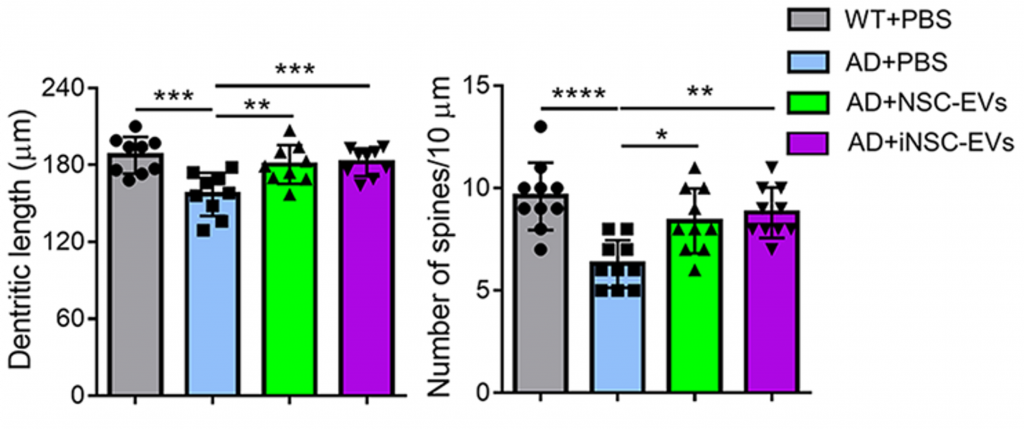Key Points:
- EVs secreted from neural stem cells (NSCs) improve the memory of Alzheimer’s disease (AD) mice.
- Treatment with NSC-secreted EVs counters the destruction of neurons in AD mouse brains.
- EVs reduce amyloid-beta plaques, a hallmark of AD, in AD mouse brains.
An overarching objective of aging research is to find a universal therapy capable of treating a spectrum of age-related diseases, including AD. Considering that organ degeneration is behind most age-related diseases, the organ regenerative properties of stem cell EVs may provide such a therapy.
Now, researchers from Tongji University in China present data in Signal Transduction and Targeted Therapy showing that neural stem cell-derived EVs prevent memory loss in AD mice while reducing neurodegeneration and amyloid-beta plaque buildup. These findings from Gao and colleagues suggest that stem cell EVs can treat AD.
Neural Stem Cell-Derived Extracellular Vesicles Counter Alzheimer’s
To avoid complications with harvesting neural stem cells (NSCs) from fetal brains, clinicians in the future could instead work with inducible neural stem cells (iNSCs) — skin (fibroblast) cells chemically transformed into NSCs. Therefore, Gao and colleagues tested the effects of EVs from both NSCs and iNSCs on AD mice.
To test the effect of EV treatment on memory, the researchers subjected AD mice to the Morris water maze. The results showed that compared to AD mice not treated with EVs, AD mice treated with NSC-derived EVs performed better on the Morris water maze. Furthermore, AD mice treated with iNSCs-derived EVs did just as well, suggesting that EVs from NSCs and iNSCs have similar memory-boosting effects.

Along with memory loss and dementia, AD is characterized by the degeneration of neurons. To assess degeneration, Gao and colleagues measured the length and number of dendritic spines — tiny outgrowths from neurons that receive information from other neurons — found in AD mouse brains. The results showed that EVs from both NSCs and iNSCs increased the length and number of dendrites, suggesting that both types of EVs counter neurodegeneration.

A hallmark of AD that is often targeted by drug companies to treat AD is a protein called amyloid-beta. Amyloid-beta aggregates and forms plaques in AD patient and mouse model brains. Gao and colleagues showed that EVs from NSCs reduced these plaques in AD mice while EVs from iNSCs did the same.

Overall, the findings of Gao and colleagues suggest that EVs from NSCs counter AD progression by preventing memory loss and reducing neurodegeneration and amyloid-beta plaque buildup. Furthermore, EVs secreted by either natural NSCs or iNSCs have a similar effect. Therefore, iNSCs may be preferred over NSCs to avoid various complications, including ethical issues stemming from the use of fetuses.
The Magic of Stem Cell-Secreted Extracellular Vesicles
Stem cell EVs have previously been shown to prolong the lifespan of old rats while improving their exercise capacity and heart function. Furthermore, stem cell-secreted EVs have been shown to treat arthritis in rats while improving their grip strength, and hair regrowth, while enhancing the memory of aged mice. Along with Gao and colleagues’ findings, these studies give heed to the idea that EVs secreted from young stem cells could treat multiple age-related diseases.